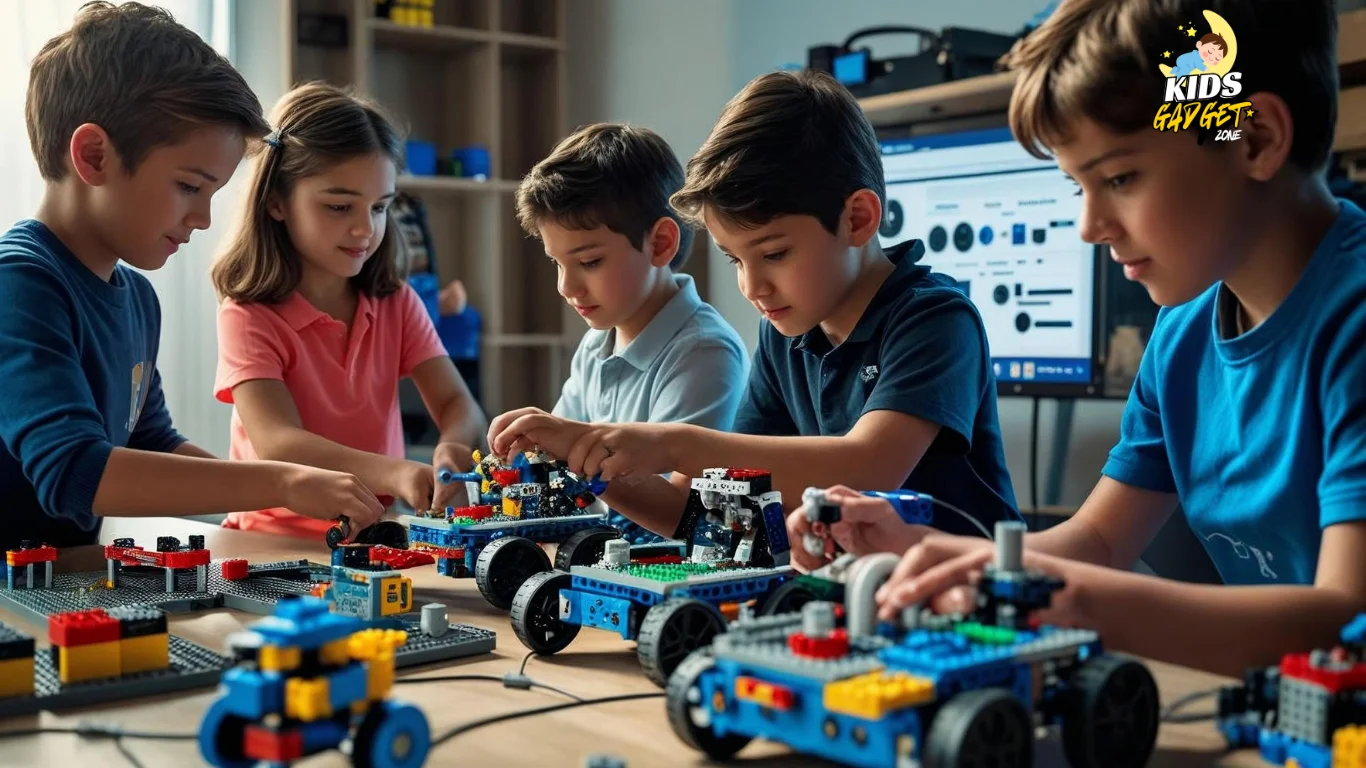My nephew, Alex, was captivated by a simple robot kit at age seven. He spent hours tinkering, and while it wasn’t perfect, his enthusiasm was infectious. This got me thinking: What age should kids start robotics? This post explores the ideal age, benefits, and how to introduce your child to this exciting field. You’ll gain insights into age-appropriate activities, resources, and ways to nurture your child’s interest in STEM and robotics.
Introducing Children to Robotics
This section explores the best age to begin introducing children to the fundamentals of robotics and the benefits of early exposure.
Age-Appropriate Introduction
- Many experts suggest starting as early as age 5 or 6 with simple, hands-on activities like building with LEGOs or engaging with basic programmable toys. These activities help develop fine motor skills and problem-solving abilities, which are crucial for robotics.
- Between ages 6 and 8, children can begin to grasp more complex concepts like sequencing and cause and effect through age-appropriate robotics kits. These kits usually involve simple programming interfaces and pre-built components.
- From ages 9-12, more advanced robotics kits with visual programming languages like Scratch can be introduced. This allows them to create more complex programs and design more intricate robots.
Benefits of Early Exposure to Robotics
- Develops Problem-Solving Skills: Robotics challenges kids to think critically and find creative solutions to problems. They learn to debug code, troubleshoot mechanical issues, and adapt to unexpected results.
- Enhances STEM Education: Robotics combines science, technology, engineering, and math, providing a fun and engaging way to learn these crucial subjects. Early exposure lays a strong foundation for future STEM pursuits.
- Fosters Creativity and Innovation: Robotics encourages children to think outside the box and come up with innovative solutions. They are free to design and build their own robots, fostering imagination and inventiveness.
Choosing the Right Robotics Kit
This section will guide you through the process of selecting the appropriate robotics kit based on your child’s age and skill level. Factors such as programming complexity, construction difficulty and cost are considered.
Considering Age and Skill Level
Choosing the right robotics kit is crucial for success. A kit too simple can be boring, while one too complex can be frustrating. Consider your child’s existing skills, patience, and interest level when making your selection.
- For younger children (5-7): Look for kits with large, easy-to-manipulate pieces and simple instructions. These kits often focus on basic assembly and introduce fundamental engineering concepts.
- For older children (8-12): Consider kits with more intricate mechanisms and programming capabilities. These kits often utilize visual programming languages, allowing for more advanced robot designs and functionality.
- For teenagers (13+): Advanced robotics kits incorporating more complex programming languages like Python or C++ may be suitable. These kits allow for sophisticated programming and control over robot movements and sensors.
Types of Robotics Kits
- LEGO Mindstorms: A popular and versatile option, offering various kits for different age groups and skill levels. LEGO Mindstorms integrates physical construction with coding, promoting creative design and programming.
- VEX Robotics: These kits are more advanced, designed for older children and teenagers. They feature a wide range of components and challenges, allowing for the construction of complex robots.
- Botley and Code-a-pillar: These are great introductory robots for preschoolers and younger elementary students. They are primarily geared toward teaching sequencing and problem-solving with limited coding capabilities.
Building a Supportive Learning Environment
A supportive environment is crucial to foster a child’s interest in robotics. This section will discuss creating a space conducive to experimentation and learning from mistakes.
Creating a Dedicated Workspace
Providing a dedicated space for building and programming robots helps maintain organization and reduces clutter. A clean, well-lit area with ample space is vital. Consider having a designated storage solution for robot parts and tools.
- Designate a specific area for robotics activities, such as a table or desk. Ensure the workspace is well-lit and has enough room for your child to spread out their materials.
- Provide storage solutions for robot parts, tools, and instructions. Use containers, organizers, or drawers to keep everything neatly stored and easily accessible.
Encouraging Exploration and Experimentation
It’s vital to emphasize the learning process rather than achieving perfect results immediately. Mistakes are opportunities for learning and growth in robotics.
- Encourage experimentation: Let your child explore different designs and programming techniques, even if it means making mistakes. Mistakes are a valuable part of the learning process.
- Provide positive reinforcement: Focus on effort and progress rather than perfection. Celebrate successes and offer encouragement when challenges arise.
- Offer guidance without over-directing: Guide your child towards solutions without explicitly giving answers. This will help them develop their problem-solving skills independently.
Overcoming Common Challenges
This section addresses common obstacles parents and children encounter when engaging with robotics. Understanding these potential hurdles helps prepare for a smoother learning experience.
Debugging and Troubleshooting
Debugging and troubleshooting are integral parts of robotics. Patience and methodical problem-solving skills are essential. Visual debugging tools can simplify the process, especially for younger children.
- Encourage systematic troubleshooting: Teach your child to break down complex problems into smaller, manageable steps. This will help them identify the source of the issue more effectively.
- Use visual aids: Visual programming languages often provide visual representations of the code, making it easier to identify errors. Tracing the code step-by-step can also be helpful.
- Utilize online resources: Many online forums and communities provide support for various robotics kits and programming languages. These resources can be invaluable for finding solutions to common problems.
Addressing Frustration
Frustration is a normal part of learning, especially when tackling challenging tasks. Maintaining a positive attitude is crucial to overcoming setbacks.
- Take breaks: When your child becomes frustrated, encourage them to take a break and return to the task later with a fresh perspective.
- Celebrate small victories: Acknowledge and celebrate even small accomplishments. This will boost their confidence and encourage them to persist.
- Focus on the learning process: Emphasize the importance of learning and problem-solving rather than solely on achieving a perfect result.
Debunking Myths about Robotics for Kids
Myth 1: Robotics is only for boys.
This is a harmful misconception. Girls are just as capable and interested in robotics as boys. Encouraging girls to pursue STEM fields, including robotics, is crucial for gender equality and diversity in technology.
Myth 2: You need to be a coding expert to start.
Many beginner robotics kits use visual programming languages that require minimal coding knowledge. This makes it accessible even to children with little to no prior programming experience.
Myth 3: Robotics is too expensive.
There’s a wide range of robotics kits available, catering to various budgets. Affordable options are available for beginners, and as your child’s skills and interests develop, you can invest in more advanced and potentially more expensive kits.
FAQ
What is the minimum age for a child to start learning robotics?
There’s no single minimum age. Some children may start exploring robotics concepts as young as 5 using simple building toys, while others might benefit from starting later. The key is to find age-appropriate activities and resources.
What if my child isn’t interested in coding?
Not all robotics involves extensive coding. Some kits focus more on mechanical assembly and design. Even if your child isn’t interested in programming, they can still benefit from the hands-on experience and problem-solving challenges offered by robotics.
Are there any free resources available for learning robotics?
Yes, many free online resources and tutorials are available for learning robotics. Websites like Scratch offer visual programming interfaces, and YouTube has numerous videos demonstrating robotics projects and techniques.
How much time should I dedicate to helping my child with robotics?
The amount of time you dedicate depends on your child’s age and skill level. Start with short, focused sessions, and gradually increase the duration as your child’s interest and abilities grow.
What are some ways to keep my child engaged in robotics over the long term?
Join a robotics club, participate in competitions, find online communities, explore advanced kits and projects. Keeping it fun and challenging will maintain your child’s engagement.
How can I assess my child’s progress in robotics?
Observe their problem-solving skills, their ability to build and program robots, and their enthusiasm for the subject. Focus on their growth and progress rather than comparing them to others.
What career paths are open to children who develop an interest in robotics?
A strong foundation in robotics can open doors to careers in engineering, computer science, artificial intelligence, and many other STEM fields. Robotics skills are highly valued in today’s technology-driven world.
Final Thoughts
Introducing children to robotics at an early age can foster creativity, problem-solving skills, and a passion for STEM. While there isn’t a magic age, choosing age-appropriate kits, creating a supportive environment, and focusing on the learning process are crucial. Remember to celebrate successes, encourage experimentation, and help your child overcome challenges. By nurturing their curiosity and enthusiasm, you can empower them to become innovators and problem-solvers in the exciting world of robotics.

